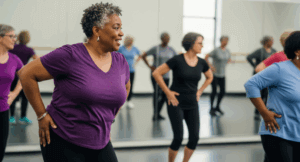Have you considered how chair yoga could transform your approach to self-care and mindfulness? It’s a practice that doesn’t require special equipment and can easily fit into your daily life. By integrating simple poses and mindful breathing, you can enhance your well-being and foster a sense of calm. But what specific benefits can chair yoga offer, and how can you incorporate it seamlessly into your routine? Let’s explore this further.
Key Takeaways
- Chair yoga enhances self-care by improving flexibility and strength, allowing individuals to assist others better while nurturing themselves.
- Mindfulness during chair yoga promotes awareness of breath and bodily sensations, fostering a calm and centered mindset.
- Practicing chair yoga reduces stress and anxiety, contributing to overall mental well-being and a balanced life.
- Incorporating short chair yoga sessions throughout the day creates opportunities for mindful breaks, enhancing focus and reducing tension.
- Engaging in chair yoga with others fosters community and connection, enriching the self-care experience through shared practice.
The Benefits of Chair Yoga
Chair yoga offers numerous benefits, especially if you’re looking for a gentle way to incorporate movement into your day. It’s an excellent practice for those wanting to serve others by enhancing their well-being.
By engaging in chair yoga, you can improve flexibility and strength, which can help you better assist those around you. It also promotes mindfulness, allowing you to be present and attentive when interacting with others.
Moreover, chair yoga can reduce stress and anxiety, enabling you to approach your caregiving roles with a calm and centered mindset.
This practice fosters a sense of community, as you can share these moments with friends or family, enhancing connections while promoting overall health.
Embrace chair yoga for a more balanced, fulfilling life.
Basic Chair Yoga Poses to Get Started
Getting started with chair yoga is easy, and you don’t need any special equipment.
Begin with a simple seated posture: sit tall in your chair, feet flat on the ground, and take a few deep breaths.
Next, try neck rolls to release tension; gently tilt your head side to side.
For shoulder mobility, raise your shoulders towards your ears and then release them down.
You can also practice seated cat-cow stretches by arching your back and then rounding it while seated.
Finally, try seated forward bends to stretch your spine and hamstrings.
These basic poses not only enhance your well-being but also prepare you to serve others with a clear mind and open heart.
Enjoy the journey!
Incorporating Chair Yoga Into Your Daily Routine
Incorporating chair yoga into your daily routine can be a refreshing way to enhance both your physical and mental well-being. You don’t need a lot of time or space; just a sturdy chair and a few minutes throughout your day.
Consider starting your morning with gentle stretches to awaken your body, or take a short break during work to relieve tension in your shoulders and neck. If you’re caring for others, invite them to join you in a few poses; it can foster connection and shared well-being.
Even during quiet moments, like waiting or unwinding at home, you can practice simple seated poses. By making chair yoga a regular habit, you’ll not only nurture yourself but also inspire those around you.
Mindfulness Practices to Enhance Your Chair Yoga Experience
While you practice chair yoga, integrating mindfulness techniques can deepen your experience and enhance the benefits.
Start by setting an intention for your session, focusing on how you can serve others through your practice. As you move through each pose, pay attention to your breath; let it guide your movements and bring awareness to your body.
Notice any sensations or thoughts that arise, and gently acknowledge them without judgment. You might also try visualizing sending positive energy to those you care for, enhancing your connection to them.
Finally, conclude your session with gratitude, reflecting on the ways your practice can uplift not just yourself, but also those around you. This mindful approach fosters compassion and a sense of community.




